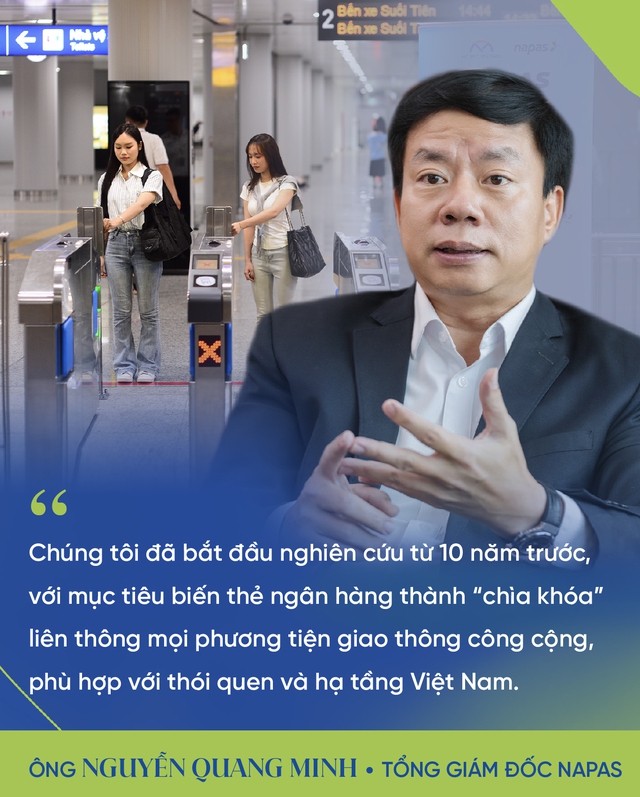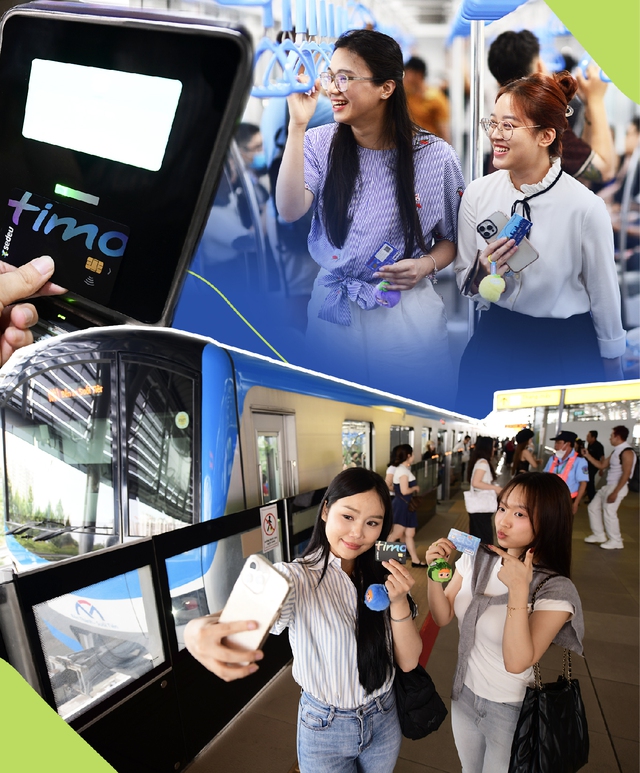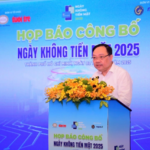Cashless payments are becoming a global trend, especially in public transportation, offering convenience, transparency, and efficiency. As Vietnam embraces metro and electric bus projects, NAPAS has taken the lead in turning bank cards into a “convergence point” for seamless travel across all modes of transport.
We had the pleasure of interviewing Mr. Nguyen Quang Minh, CEO of NAPAS, to gain deeper insights into the journey of transforming bank cards into the “key” to seamless travel and building a sustainable future.

Mr. Nguyen Quang Minh, how has the world implemented cashless payments in public transportation?
The world is far ahead of us in this field, and each country has its unique story. Over a decade ago, electronic ticketing or Card-Based Ticketing was a popular solution. These cards stored a value that was deducted with each use and recharged when empty. However, this approach soon revealed its limitations. In Singapore, for instance, residents had to carry multiple cards: EasyLink for the metro, NETS for buses and convenience stores. No single card could be used for all public transport and payment transactions. The technological disparity caused significant inconvenience. Singapore later introduced the CEPAS standard, requiring all card issuers to comply for interoperability, but this didn’t entirely resolve the issue.
Japan is even more complex, with around ten types of cards like Suica and Pasmo for different metro lines or specific cities like Tokyo and Kyoto. They opted to integrate support for all these cards into the card readers, creating a massive and complicated workload. It also made it very challenging to change fare policies over time, and each card reader could only support a limited number of cards due to storage and security constraints. While interoperability improved, both countries faced challenges in service operations, especially for tourists who had to purchase cards, make deposits, and couldn’t get refunds when leaving—a less-than-pleasant experience.
Recently, with the advancement of contactless card technology based on the EMV standard, many countries have shifted to open-loop systems. These systems allow the use of bank cards as tickets on various modes of transport, including buses, metros, and trains, instead of requiring specialized transport cards.

What was the turning point that led to this global shift, and what lessons did NAPAS draw from it?
London has been a leader in adopting digital payment solutions for public transportation. The crucial turning point came with Account-Based Ticketing. Instead of storing value on the card, the balance information is stored on a central server, leveraging advanced telecommunication infrastructure. Transport for London (TfL) pioneered the use of bank cards compliant with the EMV contactless standard, such as Visa and Mastercard, for direct payments since 2012, eliminating the need for separate transport cards. By December 2023, over 75% of the 167 million monthly transactions in London were made using bank cards, while the traditional Oyster card accounted for less than 25%. This model has spread to countries like Canada, Australia, New Zealand, and recently Singapore and China, which previously restricted the use of international cards.
I recall visiting TfL and witnessing how Londoners could simply tap their bank cards to travel from bus to metro without queuing for tickets. This inspired NAPAS to realize that Vietnam could skip the Card-Based Ticketing phase and move directly to Account-Based Ticketing, leveraging the 65 million NAPAS contactless cards already in circulation. We began our research over a decade ago, aiming to transform bank cards into the “key” to seamless travel across public transport, aligning with Vietnamese habits and infrastructure.

What challenges did NAPAS face when bringing this idea to Vietnam, Mr. Minh?
The reality in Vietnam is quite different from that of developed countries. People are accustomed to paper tickets, especially for buses, or queuing to top up their transport cards. The lack of interoperability among transport cards, with each mode of transport requiring a separate ticket, causes inconvenience. When working with VinBus in Hanoi, VinBus had to spend several months negotiating with state management agencies to transition from paper tickets to electronic ones. Previously, paper tickets were stored in warehouses, transferred to operators, and reconciled at the end of the period to calculate subsidies—a complex and time-consuming process. While electronic ticketing on VinBus buses represents a step towards cashless payments, it still falls short of achieving the level of interoperability found in developed countries.
Transaction speed is another significant challenge. The transportation industry demands a maximum transaction time of 250 milliseconds, much faster than typical bank transactions.
To implement electronic ticketing for VinBus, NAPAS designed a specialized transaction type for transportation payments, employing a “delayed” authorization mechanism. When a passenger taps their card, the reader verifies the card’s validity, ensuring it is issued by a NAPAS member bank and is still active and not restricted. This process is handled offline at the reader within the time limit required by the transportation industry. The passenger can then begin their journey immediately, while the authorization request is sent later to the issuing bank to check the balance and deduct the fare. If the account lacks sufficient funds, the passenger is added to a restricted list, preventing further trips, and a debt is recorded in the system.
This transaction mechanism inherently carries the risk of the first ride (First-ride Risk) if the passenger’s account doesn’t hold enough funds for the fare. In many countries, a risk-sharing mechanism is employed among transportation operators, card organizations, and issuing banks. One of the obstacles to implementing electronic ticketing for public transport in Vietnam is the lack of regulations governing risk handling in payment activities, and banks are not allowed to establish risk reserve funds for card payment activities. Currently, NAPAS is coordinating with banks to establish a risk-sharing mechanism with transportation operators.

What other obstacles has NAPAS encountered, and how have you overcome them?
Changing people’s habits is a significant barrier. Many individuals, especially those not working in offices, are accustomed to using cash.
Banks also need to adjust their systems to support certain features specific to transportation transactions to enhance the user experience.
Despite these challenges, NAPAS has made considerable progress in implementing payment solutions in public transportation. Since 2021, NAPAS has collaborated with VinBus to introduce NAPAS card payments on electric buses in Hanoi and Ho Chi Minh City. Earlier this year, the Metro Line 1 Ben Thanh – Suoi Tien officially adopted Account-Based Ticketing, enabling the use of NAPAS cards issued by 25 banks, international cards, and e-wallets at the fare gates. We’ve observed an average weekly growth of nearly 5% in the number of NAPAS card users, indicating that people are gradually embracing this new payment method.

Looking to the future, what plans does NAPAS have to expand cashless payments in public transportation?
Our success with the Ho Chi Minh City Metro is just the beginning, but we aim to go further. NAPAS is collaborating with entities like Hanoi Metro, Transerco, XanhSM, and Grab to replicate the model of using bank cards for transportation services in Hanoi and other localities. We’re also exploring expansions into buses, electric vehicles, and bike-sharing services to create an interconnected public transport ecosystem. Imagine a day when you can seamlessly travel from bus to metro and then rent a bicycle with just a tap of your NAPAS card, a VietQR code, or a digital card on your phone—that’s our goal.
To achieve this, NAPAS has proposed specific solutions to the authorities. First, the State Bank of Vietnam and the Ministry of Construction should promote the adoption of Account-Based Ticketing with cards adhering to the international EMV standard, replacing traditional tickets. While transport operators can maintain their standards, they must support bank cards. Second, localities should include the cost of card readers in the operational cost norms. Third, regulations and mechanisms should be established to enable banks to manage risks in payment activities.

To realize this goal, the support of the people is essential. How is NAPAS working to change user habits and promote green transportation?
Vietnamese people are open to new things if they are simple and convenient. NAPAS has coordinated with banks to waive processing fees for transportation transactions since December 2021 and has organized promotional programs, such as gift giveaways for card users at the Ho Chi Minh City Metro, with plans to implement fare discounts and rewards. We’ve also intensified our communication efforts through collaborations with KOLs, fan pages, and events in the financial and tourism sectors to spread the message of green transportation and cashless payments.
The Ho Chi Minh City Metro, with its modern design, has the potential to attract commuters as it passes through densely populated and office-centric areas. We believe that positive communication and a seamless experience will encourage people to switch from paper tickets to bank cards.
To contribute to the development of smart cities, does NAPAS plan to expand its payment model beyond transportation to other sectors?
Absolutely. NAPAS is targeting the healthcare sector, which holds potential yet faces numerous challenges. Payments in hospitals are currently complex and time-consuming. NAPAS proposes a system that allows patients to tap their cards immediately after the doctor’s prescribed tests, avoiding long queues. With the agreement of the management authorities, NAPAS believes it can bring about positive change.
NAPAS’s vision is to build a smart payment platform for smart cities. Bank cards will become the “key” to accessing various services, including transportation, healthcare, education, and commerce. Our technology infrastructure is ready, complying with the VCCS standard for domestic chip cards set by the State Bank of Vietnam, supporting VietQR payments, and enabling card digitization on smart devices. We are awaiting market consensus and supportive policies.

How confident are you in realizing this ambitious vision, Mr. Minh?
Thank you, Mr. Minh, for sharing these fascinating insights!
The Ultimate Guide to Closing Your Unverified Biometric Bank Account
As per the latest announcement from the Payment Department of the State Bank of Vietnam, banks are expected to close all accounts that have not undergone biometric verification by September. This proactive measure is aimed at curbing fraud and preventing potential misuse by criminals. Since the implementation of biometric verification, over 86 million accounts, which could potentially be dormant, fraudulent, or inactive, have been identified and will be purged from the system.
Mr. Pham Anh Tuan: Nearly 86 Million Accounts “Wiped Out” Post-Biometric Authentication
“Prior to the implementation of the new authentication requirements by the State Bank of Vietnam, the country boasted an impressive 200 million bank accounts. However, once the new biometric verification process was enforced, the number of active accounts stood at 113 million individual accounts and over 711,000 organizational accounts. These are the accounts that have successfully undergone the rigorous process of biometric data verification, ensuring the integrity and security of Vietnam’s national population database.”
“Eximbank Honored at the Prestigious JCB Vietnam Conference 2025”
Eximbank is proud to announce that, on the evening of May 29 in Phu Quoc, during the JCB Vietnam Conference 2025, it was awarded the prestigious “Leading Licensee in Merchant Sale Volume 2024” by JCB, a premier international card organization.
Unlocking Financial Support: Prime Minister Encourages Banks to Lower Interest Rates for the 500,000 Billion Package
“Speaking at the event, “Digital Transformation Day of the Banking Industry in 2025”, the Prime Minister urged banks to further reduce costs and be “a little more open-hearted” to reduce the interest rate of the VND 500,000 billion credit program for science, technology, innovation, digital transformation, and strategic infrastructure by at least 1.5% compared to medium- and long-term interest rates.”
“Over 108 Million Customers’ Biometric Data Verified: Unlocking the Power of Secure Authentication.”
“After a 10-month pilot of biometric authentication using the National Population Database (via CCCD chip-enabled cards and VneID), over 108 million customer records have been collected and cross-referenced with biometric data. Payments have been processed smoothly, and this initiative has helped curb incidents of fraud and financial loss for customers.”





















